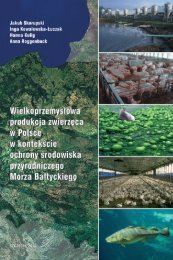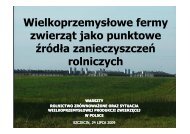best available technologies for manure treatment - Baltic Green Belt
best available technologies for manure treatment - Baltic Green Belt
best available technologies for manure treatment - Baltic Green Belt
Create successful ePaper yourself
Turn your PDF publications into a flip-book with our unique Google optimized e-Paper software.
Best Available Technologies <strong>for</strong> <strong>manure</strong> <strong>treatment</strong> baltic sea 2020<br />
Best Available Technologies <strong>for</strong> <strong>manure</strong> <strong>treatment</strong> baltic sea 2020<br />
ANNEX E: TABLES WITH SHORT DESPRIPTION OF LIVESTOCK MANURE TREATMENT TECHNOLOGIES<br />
Best Available Techniques <strong>for</strong> <strong>manure</strong> <strong>treatment</strong> - <strong>for</strong> intensive rearing of pigs in <strong>Baltic</strong> Sea Region EU Member States Technical Report "Best Practice Manure Handling, Phase 2"<br />
Ref No. 21 Ph adjustment, acidification<br />
Brief description<br />
Description of the effect on leaching (positive or<br />
negative) of N and P<br />
pH adjustment is done of the liquid livestock <strong>manure</strong> / fraction in an acid <strong>treatment</strong> unit where ammonia is bound with<br />
sulphuric acid (H2SO4) to <strong>for</strong>m ammonium sulphate in order to prevent ammonia emissions from the <strong>treatment</strong><br />
process. The acidification is thus a technology, which mainly is used <strong>for</strong> the purpose of reducing emissions from the<br />
livestock <strong>manure</strong>, which are closely related to smell/nuisances from the pig production.<br />
Typically 0.5% of the sulphuric acid, equal to 5 kg per tonnes slurry, is able to reduce pH to about 5.5, while pH in fresh<br />
pig slurry in a project is measures to about 7.3 (Siegler, 2009).<br />
The emission of methane from cattle slurry has been measure to be reduced 67-90 % (Jacobsen, 2009), and we must<br />
anticipate a similar effect <strong>for</strong> pig slurry. The content of N in the slurry is 15-20 % higher than in untreated slurry due to<br />
decreased emission of ammonia from the stable, storage and field (Jacobsen, 2009). Tests show that the emissions of<br />
laughter gas are reduced with 80%.<br />
Less emission of ammonia emissions means that<br />
less N could return as atmospheric deposition<br />
and that more N is re-circulated in the<br />
agricultural production rather than ending in the<br />
environment.<br />
Field trials indicates, that acidification of slurry<br />
affects the field effect.<br />
Field trials have shown higher field effects (bioavailability of nitrogen) of acidified slurry, however with a big variation<br />
between responses in different trials (Sørensen, 2006 and Jensen, 2006).<br />
See further under additives.<br />
Innovation stage<br />
Investment price, <br />
Basic Variable<br />
Operational costs,<br />
per tonnes<br />
per kg<br />
saved N or<br />
P leaching<br />
Complexity of implementation<br />
Research<br />
Pilot<br />
100.000 (?) 50 (?) 2 (?)<br />
Practice <br />
Major references<br />
Condition <strong>for</strong> leaching reduction<br />
effect<br />
Certainty of in<strong>for</strong>mation<br />
2-2 (N)<br />
Low – each farm can easily attach an<br />
acidification unit to the slurry system at the<br />
farm.<br />
Jacobsen, 2009<br />
Sørensen, 2006<br />
Jensen, 2006<br />
The effect will be found at all<br />
farms.<br />
Prices Low<br />
Effect on leaching Medium<br />
56<br />
Page 57<br />
56








